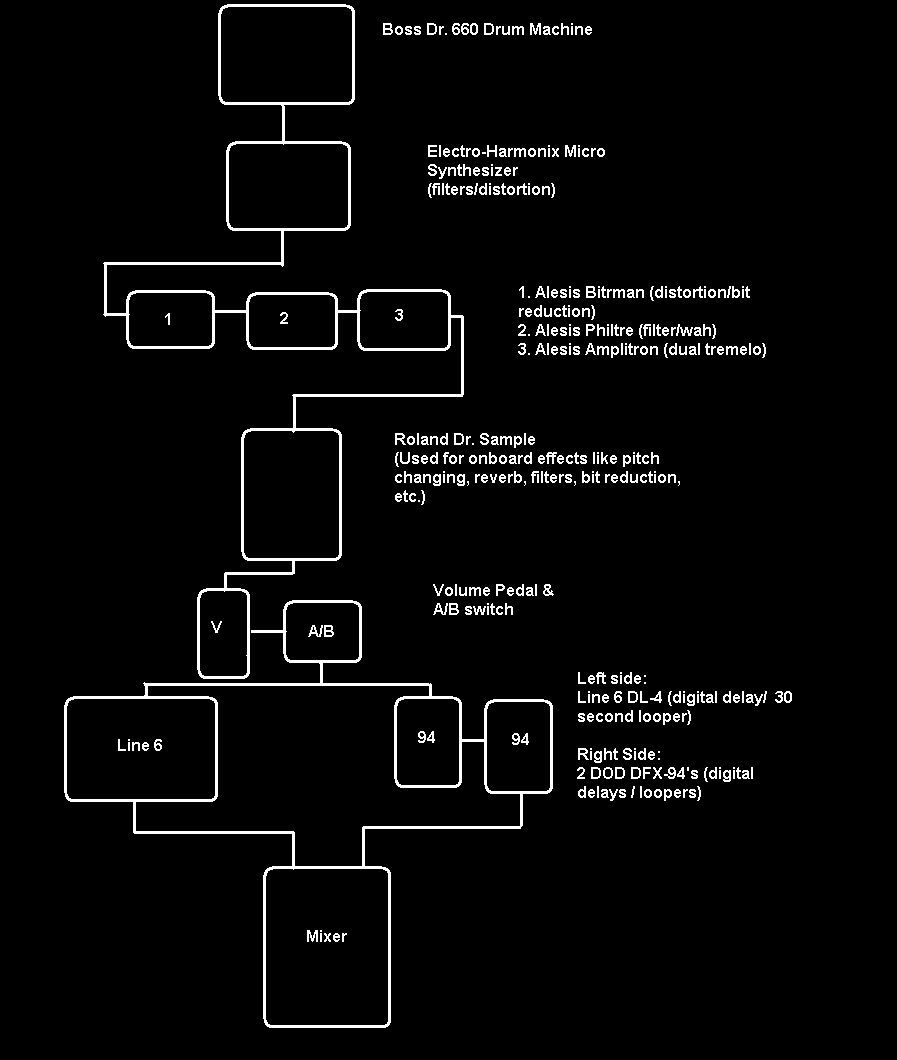| <--- I wanna go Back | |
|
Some Notes on Drum Machining
(November 24, 2006)
I originally started playing drum machine for a few reasons. For the previous several years, I'd been dabbling in sound collage (using other musicians' recordings), found objects, and field recordings. While each was giving me enjoyment and plenty to think about, none of them were offering me a large amount of musical depth or determinacy. I was getting used to trying to make use of whatever sounds came out of my gear, rather than having much choice in what those sounds would be.
On the
other hand, traditional instruments (like guitar) weren't offering me
the immediate sonic complexity that I like to build music from. To
build a complex sound with a guitar, you could spend several minutes
layering sounds, or you could run it through a bunch of distortion
pedals. Either way, there are lots of people working in that sound
world – the field is rather crowded. It's always been appealing to me
to work with unique sound sources.
I settled
on the drum machine because it turned out to have all the elements that
I enjoy working with. It has a limited sonic palette that works well
with the different effects pedals I have. Unlike most instruments, it
can be played with a single hand, and I can change one of several
parameters (volume, pitch, pulse speed) in real time while holding a
pitch. (I get extended notes by holding down the drumroll key.) It's
customizable. I can build "drum kits" that can be as predictable or
unpredictable as I want. It's small. Lastly, it's right in between
traditional music instruments (like guitar) and sound design
instruments (like laptop computer or field recordings).
The drum
machine itself (a Boss DR-660) has 255 sounds, including bass drums,
snare drums, toms, cymbals, electronic percussion sounds, cowbells,
bongos, Latin percussion sounds, metal sounds and ambient whooshes. For
each of those sounds, I can assign the pitch with a range of 4 octaves
(and an accuracy of 1/10 of a semitone). I can also assign the decay
time of each sound, the relative volume, whether it's polyphonic, and a
few other parameters. I can then assign those sounds to any of 16 drum
pads to build a kit - the machine lets me build about 30 of my own
kits. I currently have about 15 kits that I actively use, and the
average performance uses about 5. Some of the kits I use are:
Electronic tom sounds tuned to a chromatic scale (this is my favorite)
Chromatically tuned music box sounds
Very short attack/decay sounds
whooshes
chromatically tuned crash cymbals (white noise kit)
unpredictable odd percussion instruments
I treat the drum machine more or less like one of those kids who runs his guitar through 20 pedals. Actually, about half the gear I use is made specifically for guitarists. I steer towards devices that color and structure the sound, rather than simply create distortion. My favorite two effects are lo-pass filters and pitch changers. (The drum machine can change pitches too, but using another device makes the sound more abstract.)
To get
unique sounds and music from the drum machine, I run it through an
array of pedals, so there are a lot of similarities between me and
those guitarists who use large racks of gear or extensive pedalboards.
As I mentioned before, the drum machine is a one-handed instrument, so
my left hand is usually free to tweak knobs on the various boxes. The
different devices include various filters, a Dr. Sample (used only for
its on-board effects), distortion and tremolo boxes. I'm a fan of pitch
changers and lo-pass filters.
I also use looping devices to layer the sounds. The Line 6 DL-4 is a standard digital delay, with 15-30 seconds of sample memory. It allows me to pick the start and end point of a loop, which makes it easy to create rhythmic phrases if I want. It can also record/play sounds at half speed, in reverse, or both. I also use two DOD DFX-94 digital delays. These only store phrases of up to 4 seconds, and are too unpredictable to make rhythmic phrases with. However, pairing them up allows me to quickly build up complex sound environments and sustained drones. Lastly, they're the only pedal loopers that I've seen that can speed up and slow down like a tape loop. The ability to layer in sounds at different "speeds" opens up possibilities for fractured melodies.
Here's a diagram of my most common signal path:
